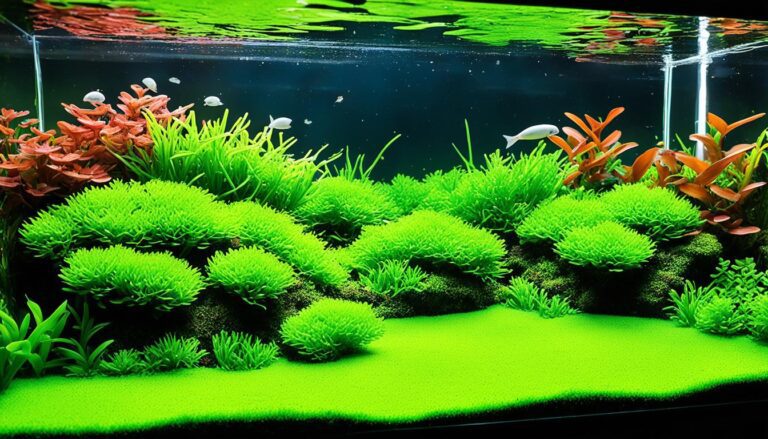I’m all about learning about duckweed, too! This little floating plant is perfect for calm freshwater tanks and can be found in places like Africa, Asia, Europe, and North America. It’s tiny, usually just 2mm to 5mm, making it a great fit for small spaces in your aquarium.
Duckweed is pretty amazing because it grows super fast and looks great! Under the right conditions, it can double its size every 8 days. It thrives in slow-moving water with temperatures between 60–90°F and a pH of 6.0–8.0, so it’s easy to keep in most freshwater tanks.
This plant isn’t just decorative—it’s a natural water cleaner! Duckweed helps remove toxins and waste from the water, reduces algae growth, and provides shade for fish that prefer less light. It even cuts down on water evaporation, which means less frequent refilling for you.
On top of that, duckweed is a nutritious snack for fish, packed with protein, fiber, and fat. However, it grows quickly, so you’ll need to keep an eye on it to prevent it from taking over. Just make sure it’s compatible with your fish and other plants to maintain a healthy balance in your tank.
Taking care of duckweed is a breeze. A little trimming here and there will keep it from spreading too much, and a balanced fertilizer will help it thrive. You don’t need special soil, and it spreads effortlessly. Duckweed not only makes your tank look great but also keeps the water clean and healthy, making it a win-win for any aquarium setup!
The Fundamentals of Duckweed in Tanks

I’m a big fan of sustainable aquaculture and have seen the good things about duckweed in tanks. This small plant helps clean the water and feeds aquatic creatures. Knowing how to care for duckweed in aquariums is key for its benefits.
Duckweed grows fast and loves calm, rich waters like its natural home. It spreads quickly, so you need to keep it in check. This means taking some steps like cutting it back to keep it from covering the whole tank.
This plant is great for sustainable aquaculture because it cleans the water and fights algae. It also takes out harmful stuff like heavy metals, making it a must-have for aquariums or ponds.
- High Nutritional Value: Duckweed is full of proteins, vitamins, and minerals, which are good for aquatic life.
- Natural Filter: It helps remove excess nutrients like nitrogen and phosphorous, keeping the water clean.
- Cost-effective Feed Option: Using duckweed can cut down on the need for other food sources, saving money.
Adding duckweed to your tank is good for sustainable aquaculture and makes the water healthier. It’s easy to take care of and has many benefits for your aquarium. Duckweed is a top choice for aquarium plants.
Growing duckweed in tanks helps feed aquatic life and makes the water better for them. It’s a green way to improve water quality. For those wanting a healthy, sustainable aquarium, duckweed is a great choice that’s easy to use and helps the environment.
Growth Conditions for Duckweed
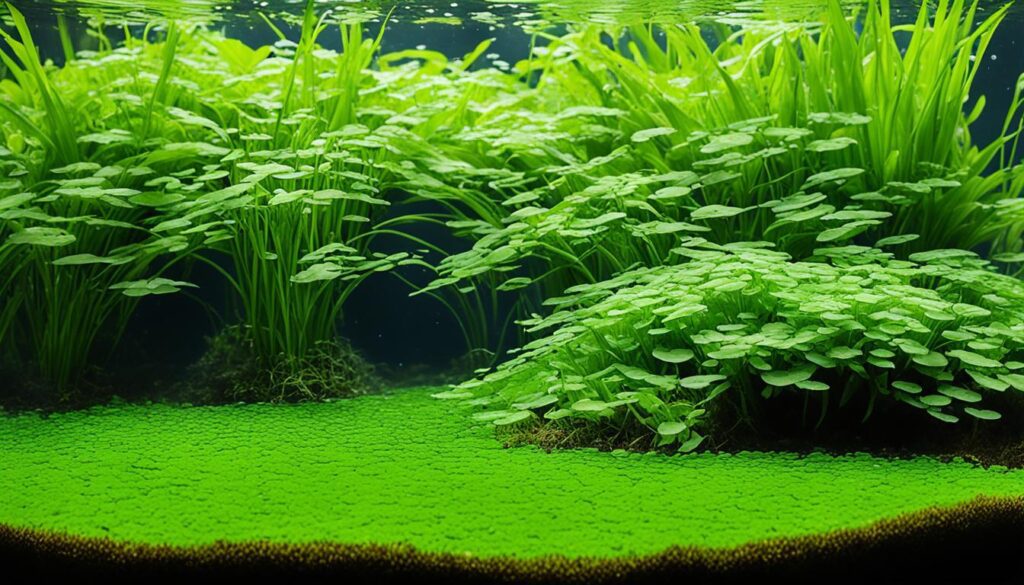
If you’re aiming to grow duckweed in your tank, there are a few key things you’ll want to get right. Duckweed can be a great resource for eco-friendly projects like bioenergy production and organic farming, but it needs the right conditions to thrive.
Getting the Right Lighting for Duckweed
Duckweed is all about the light. To grow quickly, it needs at least six hours of sunlight each day. If you’re in a spot where natural light isn’t enough, artificial lights will do the trick. This light-powered growth is what makes duckweed such a good candidate for bioenergy production—it’s all thanks to photosynthesis.
Keeping the Temperature Just Right
For duckweed to really flourish, keep the water temperature between 63°F and 79°F. Within this range, duckweed grows fast—so fast, in fact, that it can double its biomass in just three days! This makes it super versatile across different climates, and it’s also handy for wastewater treatment, as it helps stabilize water temperatures.
Maintaining Optimal Water Quality
Water quality is crucial if you want your duckweed to thrive. It does best in water with a neutral pH and lots of nutrients, especially nitrogen and phosphorus. Duckweed absorbs these nutrients, which not only helps it grow but also improves water quality. That’s why regular water checks are so important—adjusting the pH and adding minerals when needed ensures the ideal environment.
While duckweed can form thick mats on the water’s surface, make sure it doesn’t cover more than half of the water. Otherwise, it could lower oxygen levels, which could cause other problems.
Incorporating duckweed into aquatic and organic farming isn’t just great for the environment—it also helps with water purification and supports bioenergy efforts. With the right care, duckweed can be a powerful tool for both farming and sustainability goals.
Duckweed Plant Growth Rate and Tank Size Compatibility
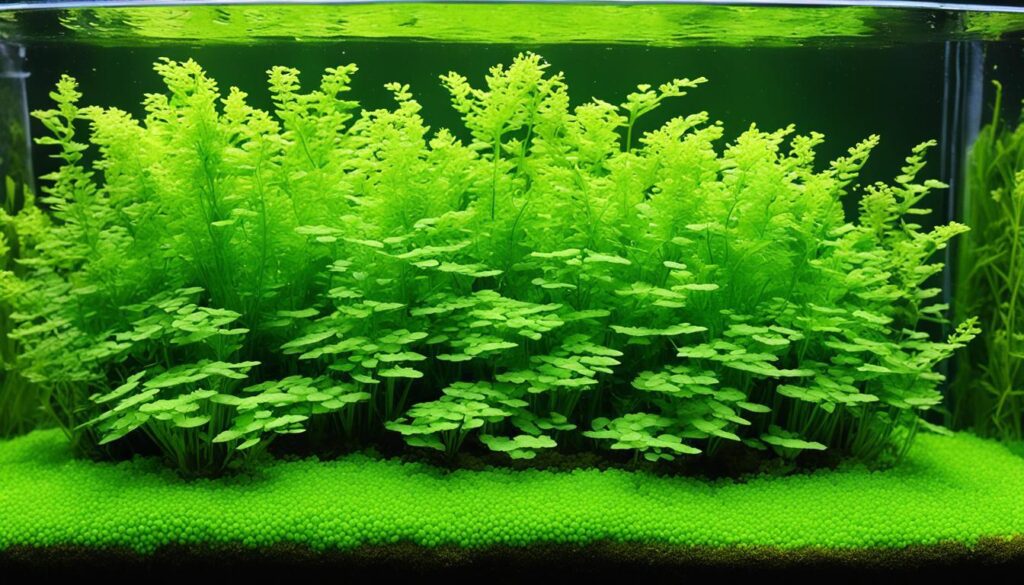
Duckweed is a fast grower, which makes it ideal for aquarists and researchers alike. The key is choosing the right tank size to keep it under control. Since duckweed can double its size in just a few days, it’s important to keep an eye on it so it doesn’t completely take over your tank.
When growing duckweed, tank depth and size really matter. Even small tanks, like polyvinyl ones that are around 0.5 x 0.5 x 0.1 meters, can support duckweed growth. This shows how versatile it can be, fitting into various aquatic setups without much hassle.
What’s really cool about duckweed is how much it benefits the environment. It can break down nearly 98% of pollutants in wetlands, making it an excellent choice for water purification. This makes duckweed not just a fast-growing plant, but a powerful tool for cleaning water in tanks and larger systems.
Tank Size (meters) |
Water Volume (liters) |
Duckweed Growth Compatibility |
|---|---|---|
0.5 x 0.5 x 0.1 |
7.5 |
Highly Compatible |
1 x 1 x 0.2 |
50 |
Compatible |
2 x 2 x 0.5 |
500 |
Compatible with regular management |
In conclusion, duckweed is a valuable plant for both decorative aquariums and environmental projects. Its fast growth and adaptability to different tank sizes make it a top choice. However, it does require regular care to enjoy its full benefits in aquariums.
Duckweed Care Best Practices
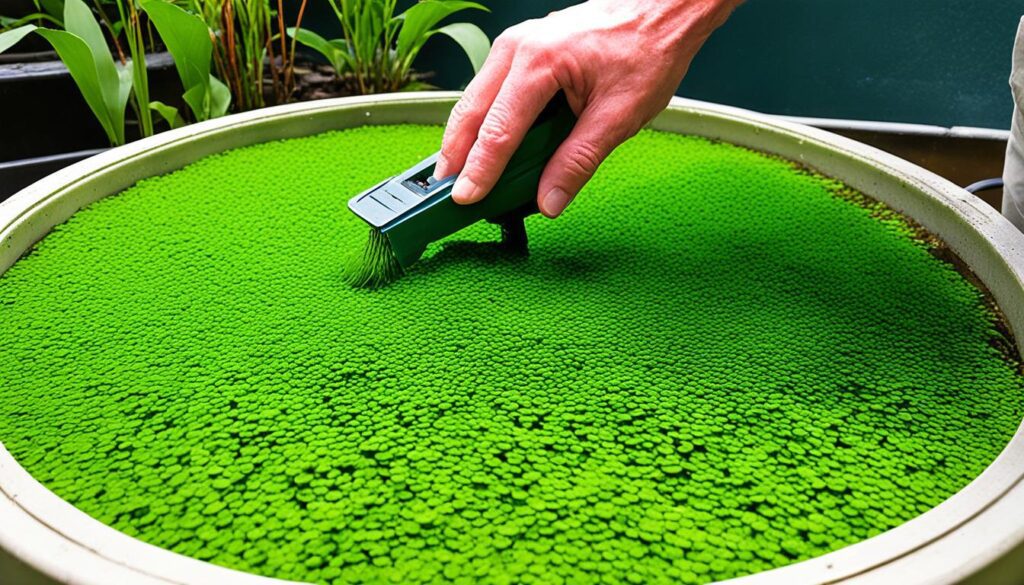
Keeping a duckweed aquarium healthy is key. It needs stable water, enough nutrients, and controlled growth to avoid overgrowth.
Maintaining the Right Environment
Duckweed grows best in temperatures between 63 to 79 degrees Fahrenheit. It also needs at least six hours of sunlight a day. This matches the natural home of plants like Spirodela polyrhiza or Lemna minuta.
It prefers water with a pH of 6.0-8.0 and should be dechlorinated. Duckweed likes still water, making it great for cleaning the water. But, it needs shade to stay healthy, so use tall plants or floating leaves to protect it from too much sunlight.
Preventing and Controlling Overgrowth
Managing duckweed growth is important. If it grows too much, it can block light and harm other aquatic life. To stop this, use floating booms or stop-boards. Adding water birds and fish that eat duckweed helps keep the ecosystem balanced.
Fertilizer Use and Nutrient Management
Once duckweed is set up, it needs little care. But, managing nutrients is key to keep it healthy and prevent too much growth. Use diluted liquid fertilizers with iron to help it grow well.
Watch for pests like weevils and the Lemna fly. Use neem oil or insecticidal soap to treat them. Also, adding baking soda can adjust the pH levels for duckweed’s comfort.
Characteristic |
Requirement |
|---|---|
Temperature |
63 to 79°F |
pH Level |
6.0 – 8.0 |
Light Exposure |
At least 6 hours daily |
Nutrient Removal Strategy |
Introduction of consuming wildlife |
Propagation Method |
Division or fragmentation |
Understanding the Ecosystem Impact of Duckweed

Duckweed isn’t just some ordinary aquatic plant; it plays a huge role in both natural and man-made ecosystems. Its rapid growth is impressive—doubling in mass every 2 to 4 days—which highlights its potential in sustainable aquaculture and bioenergy production.
One of the coolest things about duckweed is how effective it is at cleaning polluted water. It absorbs harmful substances like nitrogen, phosphates, and even heavy metals, making the water cleaner and healthier, which is super important for sustainable fish farming.
But duckweed isn’t just a water purifier. It can also be converted into renewable energy like biogas, ethanol, or even gasoline. This makes it a serious contender in reducing our dependence on fossil fuels.
And here’s something you might not know—duckweed is actually a complete protein source. It could be a game-changer for food production, and there’s even talk about using it in space to recycle wastewater and provide nutrients!
Of course, duckweed’s fast growth can be a double-edged sword. If it grows out of control, it can cover large areas of water, blocking light, reducing oxygen, and harming other aquatic life. This can reduce biodiversity if not properly managed.
Overall, duckweed is a powerhouse when it comes to cleaning water, producing energy, and supporting sustainable aquaculture. But we have to manage its growth carefully to harness its benefits without negatively impacting aquatic ecosystems.
Combining Duckweed with Fish and Other Aquatic Plants
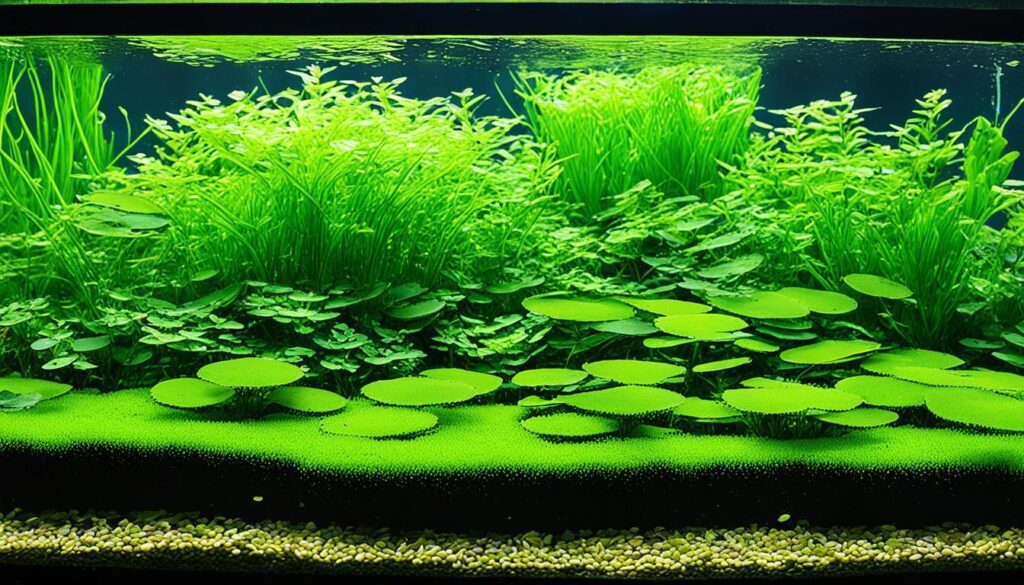
Adding duckweed to your tank can change the game for both looks and balance. It’s key to know how well duckweed gets along with your fish and other plants. Some fish, like goldfish and Dojo loaches, love duckweed for its food and hiding spots.
Duckweed does well with certain plants that like low light, like java fern and anubias. It also helps keep the water clean by taking out extra nutrients. This is good for both the fish and other plants.
But, duckweed can grow too fast and take over. This can block light for other plants. To avoid this, you might want to use duckweed rings or pick other floating plants like frogbit or Salvinia.
Consideration |
Benefits of Duckweed |
Alternative Plants |
|---|---|---|
Maintenance |
Removes excess nutrients, low-maintenance |
Frogbit, Salvinia (require similar low maintenance) |
Nutritional Value |
High, good for fish like goldfish and Dojo loaches |
Azolla species, rich in nutrients |
Light Accessibility |
Can block light if overgrown |
Red root floaters, do not overly shade below |
Compatibility with Fish |
Provides hiding and spawning sites |
Purple fringed riccia offers similar benefits |
When using duckweed in your tank, watch how it mixes with your fish and plants. Managing it well and sometimes swapping it with other plants can make sure everything thrives.
Effective Duckweed Extraction and Utilization for Aquariums
I’m a big fan of sustainable aquatic ecosystems. Adding the duckweed plant to aquariums is both an art and a science. Duckweed quickly covers calm water and helps with organic farming and keeping ecosystems balanced. To move duckweed to an aquarium, I use a fishnet or a coffee filter. This method keeps the plant and the tank’s creatures safe.
Once in the aquarium, duckweed does well with plenty of natural light. This light is good for the plant and helps clean the water. I keep the water temperature between 60–90°F and the flow slow for the best growth. It’s important to trim the duckweed regularly to stop it from taking over or blocking filters.
But, duckweed can grow too much. I use koi and goldfish to keep it in check, following organic farming and sustainability. Sometimes, I use aeration or chemicals to manage it. But, removing it by hand is still the best way to keep the aquarium balanced. Over the years, these methods have kept my aquariums healthy and full of life.
